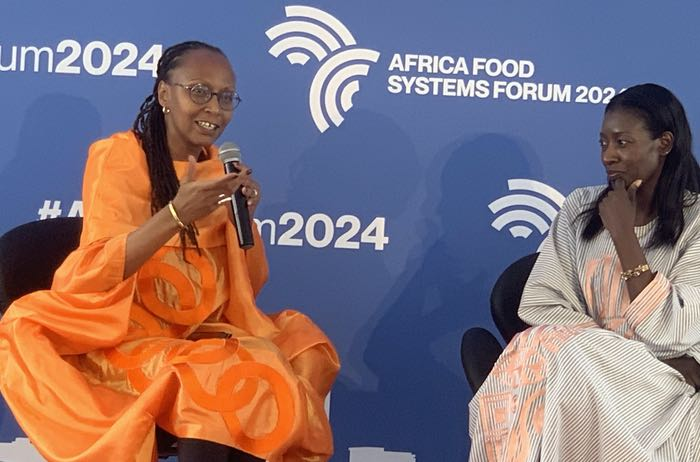
FAO Country Representative in Kigali, Coumba Sow, with Isabelle Kabano, writer of the book
The Food and Agriculture Organization of the United Nations (FAO), in collaboration with the Rwanda Arts Initiative (RAI), has launched a gastronomy book that showcases the rich culinary heritage of Rwanda and the hidden potential of local but often underutilised ingredients. The launch of Uhurimbi: Rwanda Gastronomy and Culinary Art, held at the Africa Food Systems Forum in Kigali, also underscored the critical importance of sustainable agriculture for better nutrition, focusing on crops that are well-adapted to local climates and resilient in the face of climate change.
Jeannette Kagame, the First Lady of the Republic of Rwanda, emphasized in her foreword to the book the significance of this initiative: “I, for one, look forward to seeing our different generations engage in conversations on our heritage, our values, our foods and the future of food security. It is indeed our hope that Rwanda’s gastronomy and culinary arts will, not only serve as a repository of our common heritage, but also become a standard for good health and nutrition globally.”
“Let this book inspire us all to embrace Africa’s local foods, to innovate with these remarkable ingredients, and to create a sustainable food system that nourishes people and our planet,” said FAO Assistant Director-General and Regional Representative for Africa Abebe Haile-Gabriel in his remarks at the launch event.
Africa’s overlooked culinary treasures
The book is a collaboration with four Rwandan chefs, Angelique Iraguha, Eric Kanyemera, Phiona Ninsiima and Ramadhan Sindayigaya, who have infused traditional dishes with modern culinary techniques. They use ingredients such as sorghum, taro, cowpea and nightshade, which have long been staples in the local diet, along with spider plant, impombo (finger roots), purple yam and other less-used ingredients. The recipes are complemented by stories that delve into the history and cultural significance of these ingredients, providing readers with a deeper understanding of Rwandan food traditions that they want to promote globally, including with tourists visiting Rwanda.
“To ensure that food is available in quantity, quality, and is safe, FAO and the United Nations at large is at the forefront of promoting sustainable and resilient food systems,” said FAO Representative in Rwanda Coumba Sow. “With their art of cooking and serving attractive food, chefs are not just culinary experts but also agents of change. They are pivotal in shaping public opinion and influencing consumers’ healthy eating behaviour. They inspire people globally to support sustainable food production, adopt healthy diets, and reduce food waste and loss. That is central to the message we are conveying,” said the co-author.
“By returning to our roots, we emphasize products selected for their nutritional value, cultural significance, and harmony with the climate,” said Sophie Kabano, Curator and Cultural Promoter at Rwanda Arts Initiative and co-author of the book. “By shining a light on the culinary arts, we aim not only to celebrate our rich food culture but also to support the local farmers and improve nutrition.”
Better production, better nutrition, better environment, better life
The launch of Uhurimbi: Rwanda Gastronomy and Culinary Art is part of FAO’s broader work to promote underutilized, climate-resilient crops as a means of improving nutrition and food security, and joins FAO’s work with chefs worldwide on promoting sustainable food production, diverse diets, and reduced food loss and waste. The launch aligns with the FAO Strategic Framework 2022-2031, which is organized into four betters: better production, better nutrition, a better environment, and a better life.
Above all, the book is an invitation to everyone to explore the culinary diversity of Rwanda and, by extension, the entire African continent. It calls on chefs, food enthusiasts, and global citizens to reimagine the potential of Africa’s underutilized ingredients. As the world grapples with the challenges of climate change and food insecurity, the book is a reminder that the answers often lie in the wisdom of local knowledge and traditions. (End)
